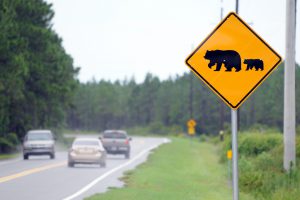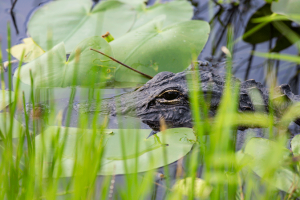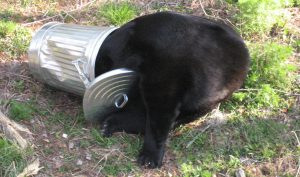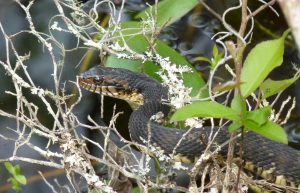Native Florida wildlife have adaptations and instincts that help them, literally, “weather the storm” during and after a hurricane. However, what is instinctual and normal for them may be unusual and concerning for us.
Post-hurricane wildlife encounters can be uncomfortable but with a little knowledge, they don’t need to be dangerous.
Wildlife Conflict, What Is It?
It’s important to remember that wildlife are, by definition, wild. They are not tame nor domesticated. They may be stressed and/or displaced due to the high winds and floodwaters. Stressed animals may act more aggressive or defensive than usual and this can create an environment ripe for wildlife conflict.

Wildlife conflicts occur when wildlife and humans interact in a way that is dangerous to us or to them, or when property damage is occurring.
Simply seeing an animal nearby or in your yard is not a wildlife conflict; this would be called a wildlife encounter. Conflict occurs when danger is present (or likely to become present) either to the human or to the wildlife in question.
Why Is Wildlife Conflict More Likely After Hurricanes?
When we look at areas flooded or drastically damaged by hurricane force winds, they look different than they did pre-hurricane, right?
Wildlife also notice how different an area looks after a hurricane and it can be disorienting. Furthermore, for some species, flood waters may give them easy access to areas they couldn’t access easily before.
Logically speaking, it makes sense that as animals learn how to navigate their new surroundings they may find themselves in new areas – either by mistake or in looking for new territories.
What Wildlife Are Affected?
It is safe to assume most wildlife in the path of a hurricane or tropical storm will be affected in some way. While people want to help wildlife showing signs of distress, you should never attempt to help or rescue a wild animal during or after the storm if it will put you or the animal in harm’s way. After the storm, you can contact a licensed wildlife rehabber if you find an injured animal.
That said, there are certain species which we may need to use extra caution around as we recover from the storm’s damage. Post-hurricane wildlife encounters do not need to be dangerous or scary … if we know what to expect.
Alligators
According to Florida Fish and Wildlife Conservation Commission (FWC), “Alligators may be observed more frequently in flooded areas after a hurricane or tropical storm. As with all wildlife, treat alligators with respect, keep them at a distance and give them space.”

If you encounter an alligator that is presenting a threat to people or property, call FWC’s Nuisance Alligator Hotline at 866-FWC-GATOR (866-392-4286).
Remember – simply seeing an alligator in a lake or flooded area is not a threat and alligators under 4ft long are generally not considered a threat to people, pets, or children. The alligator in question must also display problematic a behavior such as approaching people or pets, not fleeing when you or your boat are nearby, or being seen where they do not belong – like a back porch, a driveway, or other threatening location.
You can learn more about alligators and their normal behavior by listening to our podcast episode, Florida’s Most Recognizable Reptile: The American Alligator
Bears

Bears may take advantage of post-storm conditions when they are looking for food sources. As a reminder, bears in Florida are in a phase called “hyperphagia” in the Fall, when they need to take in roughly 4x the calories they usually need in preparation for winter.
If you have noticed bears in the area before the storm, ensure any spoiled food you are throwing out is secured separately from vegetative storm debris. We should avoid leaving attractants out for prolonged periods to reduce the risk of a bear-human wildlife conflict.
Snakes
Snakes are more likely to be seen in residential areas after flood waters come in. Rest assured, they are just an unhappy about this as you are! Snakes flee from people given the chance so, if you encounter a snake in an usual location – stay back and give it space.

According to FWC, “Most snakes you will encounter are likely to be nonvenomous and will be more scared of you than you are of them … To avoid snake bites, leave snakes alone, stay out of tall grass unless you wear thick boots, and keep hands and feet out of areas you can’t see.”
You can learn more about snakes found in our area and how to recognize them by reading the blogpost, Polk County’s Venomous Snake Species OR Commonly Confused Snakes in Central Florida.
What About Injured or Orphaned Wildlife?
It’s important to remember, wildlife parents do not have access to daycare or babysitters. But, all joking aside, they still need to run errands just like human parents do!
According to FWC, “rarely are animals actually orphaned; the parent may be searching for food or observing its young from a distance. Do not pick up baby animals or remove them from their natural environment.”
If you encounter a young animal that you suspect might have been orphaned, leave it be for awhile. If, after several hours or even a full day, you’re certain it’s parents have abandoned the young for some reason then you can consider reporting it to the nearest FWC Regional Office.
When encountering injured wildlife, please contact the appropriate FWC-licensed wildlife rehabilitator in your area. A list of wildlife rehabilitators by county can be accessed here: Licensed Wildlife Rehabilitators.
For more information, visit FWC’s Injured and Orphaned Wildlife webpage.
Sources:
- https://myfwc.com/wildlifehabitats/wildlife/bear/facts/biology/
- https://myfwc.com/news/wildlife-and-storms/
University of Florida IFAS Extension is committed to diversity of people, thought and opinion, to inclusiveness and to equal opportunity.
UF/IFAS Extension is an Equal Opportunity Institution.



